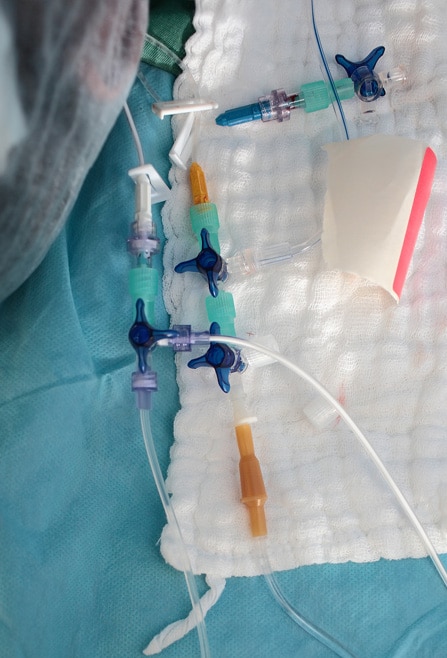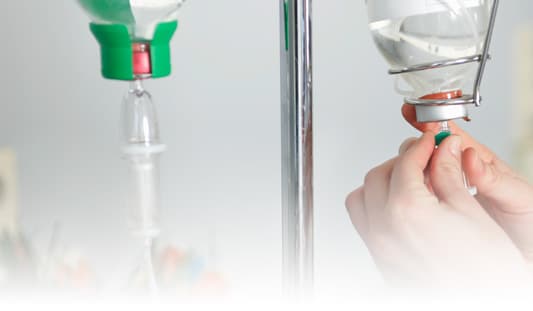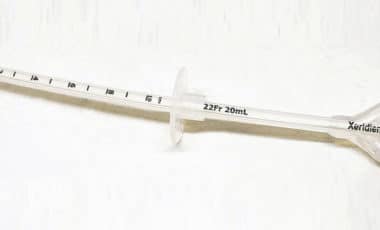
Tubing misconnections are a persistent and preventable medical error in hospitals. Why do these tragic misconnections keep happening? A combination of a defective design and the lack of training for a known danger.
- Deadly Design: tubes with different functions can easily be connected using luer connectors. Luer connectors are virtually universal, so an IV can be misconnected to a feeding tube or epidural line or blood pressure cuff.
- Lack of Training: Hospitals know that IV misconnections are deadly and yet there is a lack of nurse training and education on checking, rechecking, and tracing tubing connections after any new connection or at the handoff process.
- Safer connections available: There is still an unwillingness of hospitals and tubing manufacturers to follow through with IV connectors and other connectors that are not universal.



IV Infiltrations
IV infiltrations are also a preventable medical error in hospitals. IV infiltrations can cause serious injury such as compartment syndrome, permanent nerve damage, scarring, surgeries, and permanent disability.


Tubing Misconnections are a KNOWN Danger
HOSPITALS, MANUFACTURERS, and the U.S. GOVERNMENT have known for years that universal IV and feeding tube connectors can be easily misconnected causing serious injury and death. Some reported cases include: IV connected to epidural, IV connected to trach cuff, IV connected to nebulizer, IV connected to BP tubing, IV connected to nasal cannula, syringe connected to trach cuff, feeding tube connected to ventilator suction, IV connected to feeding tube, foley catheter connected to NG tube.
HOSPITALS, MANUFACTURERS, and the U.S. GOVERNMENT have spent years working on rules for new types of connectors that are not universal to prevent tubing misconnections. But, to date, this new standard is not being used by manufacturers or hospitals.
Hospital, Government, and Manufacturer Information on Misconnections:
FDA Warnings
Manufacturer New Design Plans
Joint Commission Warnings to Hospitals
Hospital Safety Experts
Hospital Safety Groups
Legal Help for IV Errors
What are your rights if a tubing misconnection or IV infiltration happens to you or a loved one?
It is very important to gather as much information as possible—such as what misconnection was made by hospital staff (example: IV misconnected to feeding tube) or what IV medication was infiltrated and all the details about what happened like the names of the nurses or staff who spoke with you and the type of tubing, including the name of the manufacturer(s). Video or photos are very helpful, because evidence of the misconnection or infiltration can be destroyed. If a loved one has died, an autopsy is critical. Getting copies of medical records from the hospital is vital because any attorney will need to review the records immediately to find out if there was a misconnection or infiltration. You should contact an experienced medical malpractice attorney immediately to understand your options.
Linda Thomas and Michelle Wan have almost 50 years of combined experience in handling personal injury, medical malpractice, defective product and wrongful death claims against hospitals, doctors, manufacturers across the nation.

Linda Laurent Thomas
WE CARE &
IT SHOWS.
It is an honor and privilege to represent our clients in seeking justice.

Michelle W. Wan
Frequently
Asked
Questions
I think I have a legal claim. What do I do now?
A: If you think you have a legal claim, your first step is finding a lawyer to represent you. You can contact Thomas & Wan to discuss your claim by filling this form or by calling us at 713.529.1177. A lawyer will evaluate your case.
How do I know which lawyer to use?
A: When you’re filing a lawsuit, you want to use an attorney who has experience dealing with your type of claim and a proven track record of success. Ask your attorney what kind of experience they have, how long they have been practicing, how much time they spend on cases like yours, and any other questions you may have. Most importantly, ask your attorney whether he or she will be handling the case or will be referring it to another firm. It is important that you are comfortable with and confident about your attorney, and you should never be afraid to ask questions.
Why should I hire Thomas & Wan?
A: Linda Laurent Thomas and Michelle Wan have over 45 years of combined experience in handling personal injury cases across the nation. They are routinely asked to handle legal issues and difficult cases by other law firms. Ms. Thomas and Ms. Wan approach practicing law as a profession, not a factory where a client’s case is “flipped” or referred to another law firm. They handle your case with personal service and will be happy to discuss your case with you. Most importantly, Thomas & Wan gets results. Although there is no guarantee of success in any case, Thomas & Wan will fight for your rights and keep you informed of your options.
How do I pay for an attorney?
A: Most personal injury firms, including Thomas & Wan, work on a contingency basis. This means that you only pay for our services if we win a verdict or settlement for you. If no recovery is made, you pay nothing.
Thomas & Wan has taken my case. What now?
A: The first part of the lawsuit process is called ‘discovery.’ In this phase, the lawyers for the plaintiff (you) and the defendant (the person or company you are suing) try to discover what evidence exists and how this evidence proves or disproves your claim.
Members
Of These
Organizations





Testimonials
Linda and Michelle represented me when I was hurt at a refinery. I had tried using a different lawyer, but he never returned my calls or talked to me. Linda and Michelle did a good job and they care about your case.
Rogelio L
They were very understanding and willing to work around my busy work schedule. Everything they told me that could or would happen during the case was "on point". It's been a long time coming, and the case has now been settled. I am very,very pleased that justice was well served!! With that said, I trust them and will always look to Thomas & Wan, LLP to represent myself, my family and friends with cases that involve their expertise! Thank You Thomas & Wan, LLP!!
Trina Scott
Thomas & Wan represented my baby who was seriously harmed by nurses at a hospital who did not know what they were doing. Linda and Michelle were able to guide us through what to do in getting help for my baby for the rest of his life.
Stephanie S
After a heart transplant in August 2016, Ernest “Chris” Keys can’t talk or walk. The Houston hospital is under pressure for the quality of its once-renowned heart program. Now it is being sued by Mr. Keys's family.
Houston Chronicle-July 5, 2018
Thomas & Wan did a great job representing me and my family against the owner of our apartment complex. We have just moved in when our daughter was shot in the head by a stray bullet while she was sleeping in her bed. It was a miracle she survived. The lawyers at Thomas & Wan went to work right away and through research found out that there had been five murders at that complex the year before. They also found out that the complex didn’t hire security to patrol at night. They were able to settle the case without even having to go to trial. Now were going to have the money to take care of our little girl’s needs now and in the future.
Lisa A
After being abandoned by my original lawyer who was greedy for money, Linda was a TRUE answer to my prayers. She is after JUSTICE, not money. She has spent COUNTLESS hours researching my case and asking just the right questions. She has the heart of a saint; she really cares about her clients and it shows. I have emailed her outside of our visits asking for updates or just addressing concerns I have, and she answers right away. I also have been very anxious and stressed with my case as I suffer from PTSD due to it, and she is kind, gentle, and reassuring. It truly is having an angel by your side! I don't know where I'd be without her, but I'm getting JUSTICE. If you want a piece of Heaven on Earth in your corner, GET LINDA!! She will fight for YOU, WITH you!
Lauren
I had a hard time coming to the terms with what happened to my baby at birth..and as i was looking thru and for Medical Mal Practice attorney and her face was so welcoming i loved what i read and how long she has been an attorney.our first meet and greet i was anxious and emotional and she had a comfort vibe her tone of voice..her concern about what’s happened..and her smile.. I instantly relaxed and what helped me thru my child birth complications she said it wasnt my fault and gave me a hug i cried on her shoulder and it was such amazing feeling..she understood what i was talking about.. Linda Thomas you are an amazing woman and i thank god for the opportunity of meeting a woman like yourself. I appreciate all you have helped me with and accomplish.
Alyssa
-
External IVerrors Resources




